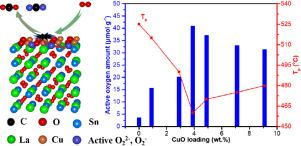当前位置:
X-MOL 学术
›
Chin. J. Catal.
›
论文详情
Our official English website, www.x-mol.net, welcomes your feedback! (Note: you will need to create a separate account there.)
Stable CuO/La2Sn2O7 catalysts for soot combustion: Study on the monolayer dispersion behavior of CuO over a La2Sn2O7 pyrochlore support
Chinese Journal of Catalysis ( IF 16.5 ) Pub Date : 2021-03-01 , DOI: 10.1016/s1872-2067(20)63657-9 Xiaohui Feng , Rui Liu , Xianglan Xu , Yunyan Tong , Shijing Zhang , Jiacheng He , Junwei Xu , Xiuzhong Fang , Xiang Wang
Chinese Journal of Catalysis ( IF 16.5 ) Pub Date : 2021-03-01 , DOI: 10.1016/s1872-2067(20)63657-9 Xiaohui Feng , Rui Liu , Xianglan Xu , Yunyan Tong , Shijing Zhang , Jiacheng He , Junwei Xu , Xiuzhong Fang , Xiang Wang

|
Abstract To understand the dispersion behavior of metal oxides on composite oxide supports and with the expectation of developing more feasible catalysts for soot oxidation, CuO/La2Sn2O7 samples containing varied CuO loadings were fabricated and characterized by different techniques and density functional theory calculations. In these catalysts, a spontaneous dispersion of CuO on the La2Sn2O7 pyrochlore support formed, having a monolayer dispersion capacity of 1.90 mmol CuO/100 m2 La2Sn2O7 surface. When loaded below this capacity, CuO exists in a sub-monolayer or monolayer state. X-ray photoelectron spectroscopy (XPS), Raman spectroscopy, and Bader charge and density of states analyses indicate that there are strong interactions between the sub-monolayer/monolayer CuO and the La2Sn2O7 support, mainly through the donation of electrons from Cu to Sn at the B-sites of the structure. In contrast, Cu has negligible interactions with La at the A-sites. This suggests that, in composite oxide supports containing multiple metals, the supported metal oxide interacts preferentially with one kind of metal cation in the support. The Raman, in situ diffuse reflectance infrared Fourier transform spectroscopy, and XPS results confirmed the formation of both O2– and O22– as the active sites on the surfaces of the CuO/La2Sn2O7 catalysts, and the concentration of these active species determines the soot combustion activity. The number of active oxygen anions increased with increase in CuO loading until the monolayer dispersion capacity was reached. Above the monolayer dispersion capacity, microsized CuO crystallites formed, and these had a negative effect on the generation of active surface oxygen sites. In summary, a highly active catalyst can be prepared by covering the surface of the La2Sn2O7 support with a CuO monolayer.
中文翻译:

用于烟尘燃烧的稳定 CuO/La2Sn2O7 催化剂:研究 CuO 在 La2Sn2O7 烧绿石载体上的单层分散行为
摘要 为了了解金属氧化物在复合氧化物载体上的分散行为,并期望开发出更可行的烟灰氧化催化剂,制备了含有不同 CuO 负载量的 CuO/La2Sn2O7 样品,并通过不同的技术和密度泛函理论计算对其进行表征。在这些催化剂中,CuO 在 La2Sn2O7 烧绿石载体上的自发分散形成,具有 1.90 mmol CuO/100 m2 La2Sn2O7 表面的单层分散能力。当负载低于此容量时,CuO 以亚单层或单层状态存在。X 射线光电子能谱 (XPS)、拉曼光谱和巴德电荷和态密度分析表明亚单层/单层 CuO 和 La2Sn2O7 载体之间存在强相互作用,主要是通过在结构的 B 位点从 Cu 向 Sn 提供电子。相比之下,Cu 在 A 位与 La 的相互作用可以忽略不计。这表明,在含有多种金属的复合氧化物载体中,负载的金属氧化物优先与载体中的一种金属阳离子相互作用。拉曼、原位漫反射红外傅里叶变换光谱和 XPS 结果证实了 O2– 和 O22– 作为 CuO/La2Sn2O7 催化剂表面活性位点的形成,这些活性物质的浓度决定了烟尘燃烧活动。活性氧阴离子的数量随着 CuO 负载量的增加而增加,直到达到单层分散能力。在单层分散能力之上,形成微米尺寸的CuO微晶,这些对表面活性氧位点的产生有负面影响。总之,可以通过用 CuO 单层覆盖 La2Sn2O7 载体表面来制备高活性催化剂。
更新日期:2021-03-01
中文翻译:

用于烟尘燃烧的稳定 CuO/La2Sn2O7 催化剂:研究 CuO 在 La2Sn2O7 烧绿石载体上的单层分散行为
摘要 为了了解金属氧化物在复合氧化物载体上的分散行为,并期望开发出更可行的烟灰氧化催化剂,制备了含有不同 CuO 负载量的 CuO/La2Sn2O7 样品,并通过不同的技术和密度泛函理论计算对其进行表征。在这些催化剂中,CuO 在 La2Sn2O7 烧绿石载体上的自发分散形成,具有 1.90 mmol CuO/100 m2 La2Sn2O7 表面的单层分散能力。当负载低于此容量时,CuO 以亚单层或单层状态存在。X 射线光电子能谱 (XPS)、拉曼光谱和巴德电荷和态密度分析表明亚单层/单层 CuO 和 La2Sn2O7 载体之间存在强相互作用,主要是通过在结构的 B 位点从 Cu 向 Sn 提供电子。相比之下,Cu 在 A 位与 La 的相互作用可以忽略不计。这表明,在含有多种金属的复合氧化物载体中,负载的金属氧化物优先与载体中的一种金属阳离子相互作用。拉曼、原位漫反射红外傅里叶变换光谱和 XPS 结果证实了 O2– 和 O22– 作为 CuO/La2Sn2O7 催化剂表面活性位点的形成,这些活性物质的浓度决定了烟尘燃烧活动。活性氧阴离子的数量随着 CuO 负载量的增加而增加,直到达到单层分散能力。在单层分散能力之上,形成微米尺寸的CuO微晶,这些对表面活性氧位点的产生有负面影响。总之,可以通过用 CuO 单层覆盖 La2Sn2O7 载体表面来制备高活性催化剂。


























 京公网安备 11010802027423号
京公网安备 11010802027423号